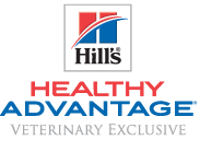
Hill's Healthy Advantage Cat Food Ingredients
According to our research, Hill's Healthy Advantage manufactures 5 cat food recipes using 89 unique ingredients. To evaluate the quality of ingredients used by Hill's Healthy Advantage, we've studied all 89 ingredients. In this article, we'll share our findings on Hill's Healthy Advantage ingredients.
| Cat Food Recipes | 5 |
| Unique Ingredients | 89 |
| Artificial Colors | 0 |
| Animal By-Products | 1 |
| Anonymous Meats | 0 |
| Controversial | 12 |
| Harmful | 2 |
First 5 Ingredients
Cat food ingredients in the United States are listed in descending order of pre-cooked weight. The first 5 ingredients typically constitute a significant portion of the recipe.
For Hill's Healthy Advantage, these are the most common ingredients found within the first 5 cat food ingredients.
- chicken broth
- chicken
- pork liver
- wheat flour
- carrot
As you can see, the most common first ingredient in Hill's Healthy Advantage is chicken broth. The most common 2nd ingredient is chicken, followed by pork liver, wheat flour, and carrot.
Artificial Food Coloring Dyes
Hill's Healthy Advantage does not use any artificial food coloring dyes. According to our records, none of the 5 Hill's Healthy Advantage cat foods contain artificial food dyes.
Artificial food coloring dyes are unnecessary and potentially harmful ingredients. In general, we not not recommend feeding any pet foods that contain artificial dyes.
In 2010, the CSPI raised serious concerns regarding the safety of many artificial dyes. Most of the studies referenced by the CSPI involved prolonged or excessive consumption. Since most cats consume the same foods throughout their lives, concerns raised by the CSPI are alarming to say the least.
To read more about Artificial Food Dyes, click here.
Animal By-Products
Hill's Healthy Advantage does indeed use animal by-products. More specifically, 1 animal by-product ingredient was found during our analysis of Hill's Healthy Advantage cat food ingredients.
According to AAFCO, by-products are defined as the non-rendered, clean parts, other than meat, derived from slaughtered mammals. In other words, animal by-products are the leftover ingredients that humans typically do not consume (lung, heart, tongue, stomach, intestine, blood, etc).
Many consumers have equated animal by-products with slaughterhouse waste. Animal by-products are still very controversial. Most premium brands have abandoned them in favor of specific named organ ingredients (duck liver, chicken heart, etc).
If you must feed a product with animal by-products, ensure that the specific animal source is specified. In other words, avoid ingredients such as meat by-products or poultry by-products.
Chicken by-product meal is produced by cooking chicken by-products using a process called rendering. By-products are defined by AAFCO as the "non-rendered, clean parts, other than meat, derived from slaughtered mammals." Thus, chicken by-products contain nearly all parts of chickens which are typically not consumed by humans. These parts include the liver, lung, spleen, kidney, stomach, blood, intestine, bone, etc.
Like other meat by-products, chicken by-products are considered controversial, mainly because they are inexpensive ingredients which consumers have equated with slaughterhouse waste. However, manufactures and many experts claim that animal by-products are unjustly criticized. Proponents state that "named" by-products, such as chicken by-products, supply many important nutrients required by cats.
The following recipes contain chicken by-product meal:
Anonymous Meat Ingredients
Anonymous meats are inexpensive low-quality ingredients that can come from practically any animal. These type of ingredients are often used to produce very inexpensive cat foods.
In general, we prefer ingredients which specify the animal source used to derive the ingredient. For example, ingredients such as duck fat are much better than animal fat or poultry fat.
In our analysis, we've looked through all 89 Hill's Healthy Advantage ingredients. According to our data, Hill's Healthy Advantage does not contain any anonymous animal-based ingredients.
Cereal Grains
Certain Hill's Healthy Advantage cat food recipes contain one or more grains. The specific ingredients are listed below.
For cats, we typically recommend choosing a grain-free recipe. Cats are obligate carnivores and therefore grains are not species appropriate.
The kibble production requires a binding agent. Grains are commonly used for this purpose in cat food. When purchasing grain-free cat food, grains are often replaced with another starchy source. This is also not ideal.
To avoid grains and other starchy additions, consider feeding wet or frozen recipes.
Whole grain wheat contains the entire grain of wheat (the germ, bran, and endosperm). Wheat is the second most-produced cereal grain in the world (corn is the first). Although wheat is a controversial ingredient, it is not necessarily undesirable because it provides dietary fiber and many other nutrients. However, wheat contains a notable amount of plant based protein, which is inferior to meat based protein and therefore an undesirable substitution.
Wheat is also one of the most common ingredients to cause food allergies or intolerance. However, grains such as wheat are typically low offenders in comparison to certain protein sources (such as beef).
The following recipes contain whole grain wheat:
Wheat flour is produced by grinding uncooked wheat into a powder. In addition to dietary fiber, wheat flour provides various vitamins, minerals, and plant based protein.
Wheat is considered a controversial ingredient because of it's protein content. Plant based proteins degrade the overall protein quality in the product. In addition, many people believe wheat is one of the most common ingredients to cause food allergies or intolerance. However, grains such as wheat are typically low offenders in comparison to certain protein sources such as beef.
The following recipes contain wheat flour:
White rice is produced by removing the husk, germ, and bran of rice grains. Unlike brown rice which contains the bran and germ, white rice is nutritionally empty.
The following recipes contain white rice:
Corn gluten meal is a by-product from the production of various corn products (corn starch, corn syrup, etc). It's very high in protein (nearly 60% protein) and therefore can significant boost the protein content of the product. Because plant based proteins such as corn gluten meal are inferior to meat based proteins (lack many essential amino acids), they are not suitable substitutes.
The following recipes contain corn gluten meal:
Brewer's rice is the small fragments of rice kernel that are separated from the larger kernels of milled rice. The fragments do not contain the same nutrition profile of the whole kernel and therefore brewer's rice is a lower quality grain. Brewer's rice is typically regarded as an inexpensive and low quality filler.
The following recipes contain brewers rice:
Wheat gluten is the main protein of wheat. Although wheat gluten is mostly protein, wheat gluten is considered controversial because it significantly boosts the protein content of the product. This is undesirable because plant based protein does not provide the same amino acid profile as meat based protein.
The following recipes contain wheat gluten:
Brown rice is naturally rich in fiber and various minerals including manganese, phosphorus, and magnesium. Relative to other grains, brown rice is easy to digest.
The following recipes contain brown rice:
Whole grain corn is the entire corn kernel (the germ, bran, and endosperm). Corn is a cereal grain which provides a modest amount of vitamins, minerals, and plant based protein. It also happens to be one of the most controversial ingredients in cat food.
Proponents of corn claim that corn is highly digestible and an excellent source of protein, energy, vitamins, minerals, and essential fatty acids.
Opponents however believe that positive claims in regards to corn are either half-truths or completely false, we'll discuss a few of the opposing arguments.
In regards to digestibility, the claims of "highly digestible" are only true if corn is processed into a meal or flour and subsequently cooked. In regards to the protein contribution, we must note that corn is a plant based protein which does not contain all of the necessary amino acids required by cats to sustain life. Therefore substituting corn for meat is an unsuitable substitution and actually degrades the overall protein quality of the product.
Finally, we'll discuss the claims about vitamins and minerals in corn. Although corn does provide many vitamins and minerals, it not necessarily an exceptional ingredient in this regards. There are many other ingredients which are more complete and biologically appropriate. Therefore the usage of corn as the primary ingredient in cat food should certainly warrant further questioning.
The following recipes contain whole grain corn:
Cracked pearled barley is barley with the outer husk and bran layers removed. Similar to regular barley, cracked pearled barley provides carbohydrates and dietary fiber. Cracked pearled barley is however not as nutritious as regular whole grain barley.
The following recipes contain cracked pearled barley:
Whole grain oats are an excellent carbohydrate source with considerable nutrients in addition to dietary fiber. More specifically, oats are rich in B vitamins and various minerals including manganese.
The following recipes contain whole grain oats:
Rice starch is a gluten free carbohydrate derived from rice. Typically, rice starch is used as a binder in kibble.
The following recipes contain rice starch:
The following recipes contain oat hull:
Controversial Ingredients
In most cases, ingredients which are given the controversial classification can be substituted with higher-quality alternatives. You should evaluate each controversial ingredient independently to see if there is truly a valid cause for concern.
Keep in mind, certain sacrifices often must be made to produce cat foods at a reasonable price. In general, the more expensive the product, the fewer controversial ingredients you'll find.
In our analysis, we've identified 12 controversial ingredients inside Hill's Healthy Advantage products. These controversial ingredients are listed below. Click on each ingredient for more information.
Whole grain wheat contains the entire grain of wheat (the germ, bran, and endosperm). Wheat is the second most-produced cereal grain in the world (corn is the first). Although wheat is a controversial ingredient, it is not necessarily undesirable because it provides dietary fiber and many other nutrients. However, wheat contains a notable amount of plant based protein, which is inferior to meat based protein and therefore an undesirable substitution.
Wheat is also one of the most common ingredients to cause food allergies or intolerance. However, grains such as wheat are typically low offenders in comparison to certain protein sources (such as beef).
The following recipes contain whole grain wheat:
Pork plasma is the colorless fluid part of a pig's blood. It may sound disgusting, but it's actually very nutritious for cats. Regardless of the nutritional aspects, consumers are shocked by this ingredient, which is why pork plasma is considered a controversial ingredient.
The following recipes contain pork plasma:
White rice is produced by removing the husk, germ, and bran of rice grains. Unlike brown rice which contains the bran and germ, white rice is nutritionally empty.
The following recipes contain white rice:
Powdered cellulose is produced from minuscule pieces of wood pulp and plant fibers. Other than its fiber content, powdered cellulose lacks any nutritional contribution.
The following recipes contain powdered cellulose:
Corn gluten meal is a by-product from the production of various corn products (corn starch, corn syrup, etc). It's very high in protein (nearly 60% protein) and therefore can significant boost the protein content of the product. Because plant based proteins such as corn gluten meal are inferior to meat based proteins (lack many essential amino acids), they are not suitable substitutes.
The following recipes contain corn gluten meal:
Brewer's rice is the small fragments of rice kernel that are separated from the larger kernels of milled rice. The fragments do not contain the same nutrition profile of the whole kernel and therefore brewer's rice is a lower quality grain. Brewer's rice is typically regarded as an inexpensive and low quality filler.
The following recipes contain brewers rice:
Wheat gluten is the main protein of wheat. Although wheat gluten is mostly protein, wheat gluten is considered controversial because it significantly boosts the protein content of the product. This is undesirable because plant based protein does not provide the same amino acid profile as meat based protein.
The following recipes contain wheat gluten:
Pea protein is produced by removing the starchy parts of peas. Pea protein is considered controversial because it provides a substantial plant based protein boost. This boost is undesirable because plant based protein is typically lower in biological value when compared to meat based proteins.
The following recipes contain pea protein:
Whole grain corn is the entire corn kernel (the germ, bran, and endosperm). Corn is a cereal grain which provides a modest amount of vitamins, minerals, and plant based protein. It also happens to be one of the most controversial ingredients in cat food.
Proponents of corn claim that corn is highly digestible and an excellent source of protein, energy, vitamins, minerals, and essential fatty acids.
Opponents however believe that positive claims in regards to corn are either half-truths or completely false, we'll discuss a few of the opposing arguments.
In regards to digestibility, the claims of "highly digestible" are only true if corn is processed into a meal or flour and subsequently cooked. In regards to the protein contribution, we must note that corn is a plant based protein which does not contain all of the necessary amino acids required by cats to sustain life. Therefore substituting corn for meat is an unsuitable substitution and actually degrades the overall protein quality of the product.
Finally, we'll discuss the claims about vitamins and minerals in corn. Although corn does provide many vitamins and minerals, it not necessarily an exceptional ingredient in this regards. There are many other ingredients which are more complete and biologically appropriate. Therefore the usage of corn as the primary ingredient in cat food should certainly warrant further questioning.
The following recipes contain whole grain corn:
Caramel color is a concentrated form of caramel, a natural food colorant. Caramel color has been linked to cancer in laboratory animals. Since our pets do not care about food color, caramel color is an unnecessary addition with possible health risks.
The following recipes contain caramel color:
Chicken by-product meal is produced by cooking chicken by-products using a process called rendering. By-products are defined by AAFCO as the "non-rendered, clean parts, other than meat, derived from slaughtered mammals." Thus, chicken by-products contain nearly all parts of chickens which are typically not consumed by humans. These parts include the liver, lung, spleen, kidney, stomach, blood, intestine, bone, etc.
Like other meat by-products, chicken by-products are considered controversial, mainly because they are inexpensive ingredients which consumers have equated with slaughterhouse waste. However, manufactures and many experts claim that animal by-products are unjustly criticized. Proponents state that "named" by-products, such as chicken by-products, supply many important nutrients required by cats.
The following recipes contain chicken by-product meal:
Soy protein isolate is a highly refined/purified form of soy bean protein. Roughly 90% of soy protein isolate is protein. The inclusion of non-meat protein typically degrades the overall quality of protein in the recipe. This degradation is due to the inferior amino acid profile of plant based proteins.
The following recipes contain soybean protein isolate:
Potentially Harmful Ingredients
Harmful ingredients are those which have been linked to adverse health effects. In general, we do not recommend feeding any product which contains any harmful ingredients.
There are certain situations where these ingredients may be necessary. We always recommend contacting Hill's Healthy Advantage for further clarification regarding any harmful or controversial ingredient.
We have identified 2 harmful ingredients used in certain Hill's Healthy Advantage recipes. To learn more, click on the ingredient's name.
Menadione sodium bisulfate complex is a synthetic version of vitamin K that has been linked to many health concerns. Research has suggested possible toxic reactions in liver cells and red blood cells among other serious problems. In fact, one large chemical supplier warns, "The substance is toxic to kidneys, lungs, liver, mucous membranes. Repeated or prolonged exposure to the substance can produce target organs damage."
The following recipes contain menadione sodium bisulfate complex:
Menadione sodium bisulfite complex is a synthetic version of vitamin K that has been linked to many health concerns. Research has suggested possible toxic reactions in liver cells and red blood cells among other serious problems. In fact, one large chemical supplier warns, "The substance is toxic to kidneys, lungs, liver, mucous membranes. Repeated or prolonged exposure to the substance can produce target organs damage."
The following recipes contain menadione sodium bisulfite complex:
Hill's Healthy Advantage Cat Food Ingredient Lists
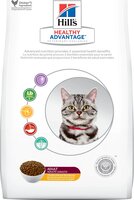
Hill's Healthy Advantage
Dry Cat Food
Chicken & Brown Rice Recipe For Adult Cats
Hill's Healthy Advantage
Dry Cat Food Chicken & Brown Rice Recipe For Adult Cats
First Five Ingredients
chickenbrown rice
whole grain wheat
pork fat
wheat gluten
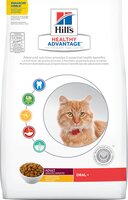
Hill's Healthy Advantage
Dry Cat Food
Chicken Flavor For Adult Cats (Oral +)
Hill's Healthy Advantage
Dry Cat Food Chicken Flavor For Adult Cats (Oral +)
First Five Ingredients
chicken by-product mealcorn gluten meal
whole grain corn
pork fat
powdered cellulose
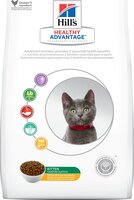
Hill's Healthy Advantage
Dry Cat Food
Chicken & Brown Rice Recipe For Kittens
Hill's Healthy Advantage
Dry Cat Food Chicken & Brown Rice Recipe For Kittens
First Five Ingredients
chickenbrown rice
chicken fat
chicken meal
whole grain wheat
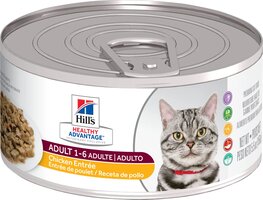
Hill's Healthy Advantage
Wet Cat Food
Chicken Entree For Adult Cats
Hill's Healthy Advantage
Wet Cat Food Chicken Entree For Adult Cats
First Five Ingredients
chicken brothchicken
pork liver
wheat flour
carrot
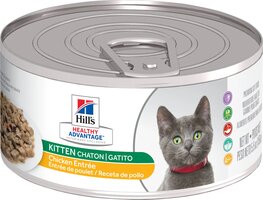
Hill's Healthy Advantage
Wet Cat Food
Chicken Entree For Kittens
Hill's Healthy Advantage
Wet Cat Food Chicken Entree For Kittens
First Five Ingredients
chicken brothchicken
pork liver
wheat flour
carrot
